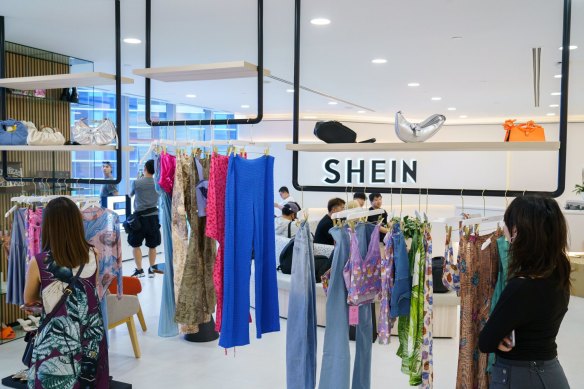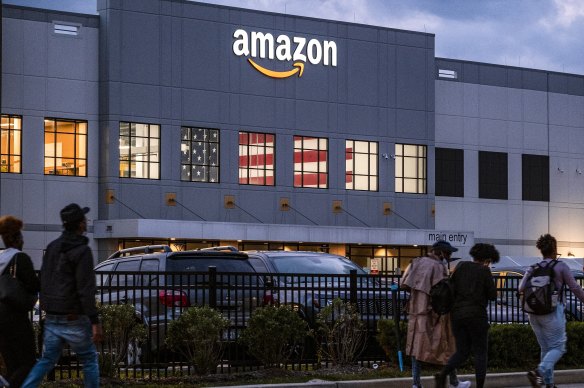
The Chinese companies use the model that Amazon is seeking to emulate: shipping individual orders direct from Chinese warehouses located close to the sellers’ factories to the purchasers of their goods.
Their success has been aided by the excess capacity in China’s factories, which has lowered factory gate prices, and also, ironically, by former US president Donald Trump’s tariffs on imports from China.

Amazon’s plan has emerged just as Shein is finalising its stock exchange listing, which will occur either in the UK or Hong Kong.Credit: Bloomberg
Those tariffs, which President Joe Biden has largely left intact, imposed a 25 per cent duty on $US250 billion of China’s exports to the US and a 7.5 per cent rate on a further $US112 billion.
Under Amazon’s existing model, its imports from China are exposed to the tariffs. Bulk apparel imports from China, for instance, incur the 25 per cent duty.
Shein and Temu, however, because they ship individual small packaged goods directly to the consumers from their warehouses in China, can take advantage of a deliberate loophole that legislators in the US, Europe, the UK and, from this month, Australia have left in their customs laws, which has abolished about 500 “nuisance tariffs” on clothing, household items and some foodstuff.
Loading
The cost of the process for imposing customs duties on small items far outweighs the revenue that could be raised, so many jurisdictions have a threshold below which no duty is levied. In the US, the “de minimus exception”, as it is called, is $US800. In Europe, it is €150 (about $240). Here, most goods that attracted a tariff rate of only 5 per cent will be duty-free.
Because they ship individual items worth less than those thresholds directly to customers rather than moving the goods in bulk, Shein and Temu don’t pay any duty on them.
Their success has been reflected in a massive increase in the number of tax-free shipments to the US.
In the 12 months to September last year, there were more than a billion of those shipments, mainly from China. That was a more than 50 per cent increase on the volume in the 2022 financial year and more than twice pre-pandemic levels.
Given the explosive rates of growth in their US user numbers, it’s a reasonable deduction that the two Chinese companies account for most of the increase in those parcel volumes.
Their success in exploiting a design feature in customs regimes in the major economies has not just helped motivate Amazon to replicate their strategies but it has also caused significant angst for US and European lawmakers.

Amazon’s speed of delivery has been key to the company’s global dominance of online retailing.Credit: AP
Amazon may have left it a little late to gatecrash the party because there are proposals within the US Congress to close off the loophole and shore up the tariff wall for imports from China by either imposing a duty of about $US7 a parcel or enacting a complete ban on low-value China-sourced imports. The issue of whether low-value packages should be duty-free is also being debated in Europe.
Amazon’s plan will, of course, attract even more attention to the duty-free imports which, if one were cynical, might be part of a plan to hobble its rapidly growing rivals by shutting them out of the US and other major Amazon markets.
There’s no segment within online retail that Amazon doesn’t want to dominate.
It may also not be coincidental that Amazon’s plan has emerged just as Shein is finalising its stock exchange listing, which will occur either in the UK or Hong Kong.
Shein, which made a $US2 billion profit last year, was valued about $US66 billion in its most recent capital raising. Any threat of an increased cost of accessing the US and/or European consumer markets would have significant adverse implications for its value in an IPO.
If the duty exceptions remain, Amazon will bring its scale and the dominance of its platform to bear on the two Chinese companies, hoping to out-compete them while shoring up its own vast customer base.
Loading
Interestingly, Amazon also recently helped fund Saks Fifth Avenue’s acquisition of rival upmarket retailer Neiman Marcus, taking up a minority interest in the merged group and offering its technology and logistics expertise to it.
Amazon has had trouble attracting the more prestigious fashion brands to its platform, which has a dedicated luxury brands section. In this instance, it seems to have decided that if it can’t attract the brands, it will buy an exposure to them.
Its actions at both the low-value and high-end of retail underscore what a competitive and ambitious beast Amazon is. There’s no segment within online retail that it doesn’t want to dominate.
The Business Briefing newsletter delivers major stories, exclusive coverage and expert opinion. Sign up to get it every weekday morning.









 Add Category
Add Category